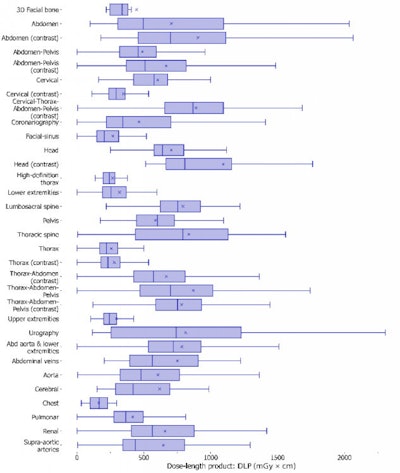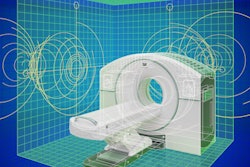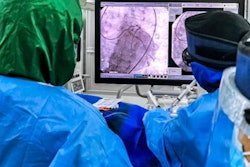
CT urography exams involved the highest radiation dose for patients, while scans of the upper and lower extremities administered the lowest dose, a large study conducted at a Spanish university hospital has revealed.
Authors from the University and Polytechnic Hospital La Fe (HUiP La Fe) in Valencia evaluated the range of patient doses, through measurable dosimetric quantities, in interventional radiology, digital x-ray, CT, and pediatric fluoroscopy. The aim was to establish local diagnostic reference levels (DRLs) for relevant diagnostic and interventional radiology procedures.
"The wider dynamic range of imaging detectors leads to a higher image quality with increasing exposure. While this is advantageous to reduce the quantity of repeated examinations due to under- or, especially, overexposure, it can also favor higher doses," noted medical physicist José Manuel Calatayud and colleagues, adding that local DRLs are useful in assessing possible trends in doses.
Five years of studies
The researchers retrospectively collected data for exams performed in 2016-2021 using DoseWatch (GE Healthcare) software connected to two CT units, three interventional radiology suites, and a pediatric diagnostic fluoroscopy room. They presented their findings in a poster at ECR 2023.
A total of 640 interventional procedures, 1927 CT studies, 2846 pediatric diagnostic interventional procedures, and 80,460 digital x-ray examinations were evaluated.
DRLs were obtained as the 75th percentile of the patient dose distribution of various procedure. For CT, the air kerma-length product (KLP) was used, and for the rest of procedures the air kerma-area product (PKA) was used. For pediatric scans, data were further classified by age range (≤ 1, 1-5, 5-10, and 10-15 years).
In digital x-ray, the largest sample size corresponded to inferior limbs with 14905 exams and the lowest to head anterior/posterior opposed (AP/PA) (n = 247). Transarterial chemoembolization was the most common procedure in interventional radiology (n = 201) and arteriovenous malformation embolization the least (n = 6); head CT studies had the largest sample size with 3581 studies and high-definition thorax the lowest (n = 46).
In pediatric fluoroscopy studies, esophagogram was the highest-performed procedure (n = 976) and intravenous pyelography was the lowest (n = 8).
According to the local DRLs of PKA for digital x-ray examinations, lumbar spine lateral exams had the largest value of exposure at 7,323 mGy·cm2, whereas superior limbs having the lowest at 145 mGy·cm2.
For interventional procedures, upper gastrointestinal tract bleeding was the procedure with the highest PKA for a local DRL, yielding 1,356 Gy·cm2. Cerebral angiography the procedure had the lowest at 114 Gy·cm2.
 Local DRLs for pediatric diagnostic fluoroscopy procedures. Figures courtesy of José Manuel Calatayud et al and presented at ECR 2023.
Local DRLs for pediatric diagnostic fluoroscopy procedures. Figures courtesy of José Manuel Calatayud et al and presented at ECR 2023.The figure above shows the results of DRLs for pediatric studies classified by age range. The procedure with the largest exposure was intravenous pyelography for the 10-15 years old range at 5,446 mGy·cm2. Percutaneous cholangiography for ≤ 1 years old had the lowest at 91.5 mGy·cm2.
DRLs for procedures generally increased with age range, except for percutaneous cholangiography in the range of 10-15 years old and intravenous pyelography in the 5-10 years old range. This was probably caused by the low number of studies evaluated (1 and 2, respectively), with the corresponding statistical fluctuations.
 Local DRLs for CT exams.
Local DRLs for CT exams.For CT exams, urography studies showed the highest value, with 1,227 mGy·cm2, and both upper and lower extremities the lowest, with 266 mGy·cm2.
"Local DRLs obtained for relevant interventional procedures can be used at center level at dose management systems for routine use in interventional procedures to monitor dosimetric quantities," the authors wrote, adding that DRLs are a useful tool in the optimization of imaging procedures and as a part of quality assurance programs.
"Emphasis should be made on the justification of medical procedures and the optimization of radiological protection to ensure that ionizing radiation is used appropriately for the particular medical purpose," they noted.
The number of some procedures was limited, the group admitted. "A minimum of 30 procedures is required to be relevant for a DRL, which was not achieved in some cases, especially when classifying data by age range in pediatric studies."
The use of patient weight instead of age may reduce the distribution of obtained data in pediatric exams. No classification by procedure complexity was considered in this work for interventional radiology procedures due to lack of information. This approach would reduce variability of dosimetric quantities in procedures, improving the quality of DRLs, they stated.
To view the whole ECR 2023 poster and learn more about the full range of cases, go to the EPOS section of the congress organizers' website.
The co-authors of the ECR e-poster were Dr. Juan Manuel Campayo, Pilar Gras, Juan Ignacio Villaescusa, and Prof. Luis Martí-Bonmatí.



















